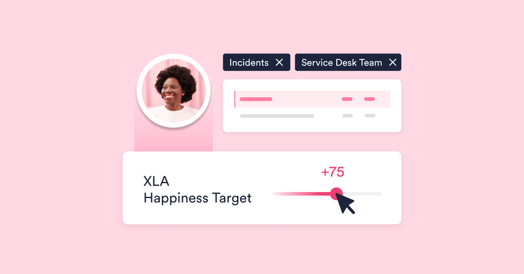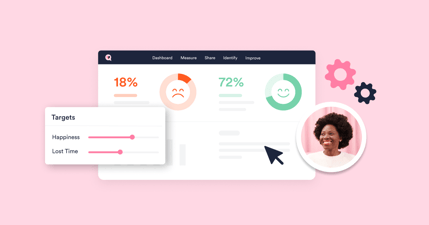An earlier blog shared the four main options for adding experience level agreement targets (XLAs) to contractual agreements. These are committing to an XLA result, committing to a digital experience result, committing to improving experience, and committing to delivering an experience management service. To help further, this blog offers more detail on what each of these four options entails for adding XLAs to contractual agreements. Starting with committing to an XLA result.
Option 1 – Committing to an XLA Result
In this option, the IT service provider commits to delivering an agreed level of XLA performance. This option is similar to the traditional service level agreement (SLA) approach organizations are accustomed to and, as such, is often the first option organizations consider for adding XLAs to contractual agreements.
However, based on our experience with customers, this approach doesn’t deliver the best possible outcome in the long term. Because if an XLA target is specified in a contractual agreement, it only establishes the “what is enough” level, which gets more problematic when the contractual agreement period is long.
Based on our interactions with customers, we recommend that organizations don’t set experience targets for longer than one year. Ideally, they should last a maximum of six months. This limitation is because employees’ experience expectations, the employed IT tools, and organizational priorities will change over time.
But when XLA scores are measured and reported continuously but contractually reviewed six monthly or annually, this poses another issue – when should the contractual review of the XLA score be undertaken? If the XLA score is taken too early, this won’t be fair to the IT service provider – because it hasn’t had a chance to improve (experiences) yet. Plus, if the score is taken for just one month – for example, the last month of the period – there’s a danger that this might be a performance “dip” month, which would again be unfair.
To avoid these issues, we recommend that organizations either:
- Calculate the XLA scores, including for penalties and rewards, from the last two months of the target period
- Follow and report the XLA scores continuously or at least monthly
- Score for each month being above 80% of the target, which allows the IT service provider to manage seasonal “dips.”
These recommendations are because experience is cumulative and will sometimes go up and sometimes go down. So, the XLA score’s trajectory matters more than the XLA score at any point in time. So, are experiences getting better or not?
Option 2 – Committing to a Digital Experience Result
Many large IT service providers use digital employee experience (DEX) tools to deliver a DEX score. The DEX score is typically out of 10, but industry best practice is moving DEX score targets toward percentages. Whether a number or a percentage, the DEX score can be a contractually committed target.
With this option, an agreed target DEX score would be stated in the contract, and the IT service provider could contractually commit to improvements such as a 10% uplift per annum. If the baseline DEX score was already very good, they might alternatively commit to not degrading the experience. If required, DEX-related penalties and rewards can also be implemented.
This option is relatively easy in measurement terms because the DEX tool produces the scores. However, there are several problems with it:
- XLAs are broader than DEX, so this is not a true XLA. A DEX score can be used in an XLA, but they’re not XLAs on their own.
- The IT service provider manages the DEX tool, and because DEX scores can be easily configured, there’s the danger that the metrics are adjusted to suit their needs.
- Not all DEX tools include experience and sentiment data. Even if they do, sometimes the DEX score is configured without sentiment. This means the DEX score is just a technical device score (T-Data), not an experience score.
Option 3 – Committing to Improving Experience
In this option, the IT service provider commits to improving experience – or maybe not degrading experience – over time. Importantly, the actual XLA score is less relevant than its direction or trajectory.
XLA scores are measured continuously, with each month’s scores and the “direction of travel” reviewed to understand the “experience trajectory.” So, has experience improved, or has it degraded?
The contractual mechanism will depend on the IT service provider’s maturity, confidence, and customer needs. For example, if both parties are experienced with XLAs and the customer baseline is low, the IT service provider can commit to a 5% or 10% improvement each year (dependent on where the starting baseline is). There could also be rewards for reaching targeted improvements. For example, if target scores have been achieved, a bonus of 5% of that target period. The achieved XLA score should be calculated from the last two months of the target period. Parties should also check that, within the measured period, every month’s score reached at least 80% of the target.
When the IT service provider is new to XLAs or the customer baseline is high, the agreement could be to improve the experience rather than commit to a certain XLA score or percentage improvement.
Option 4 – Committing to Delivering an Experience Management Service
This is the best option for organizations that are new to XLAs. No actual results or improvement levels are committed to. Instead, a commitment is given to ways of working.
The IT service provider commits to delivering an experience management service but not the result (of the experience management service). For example, the IT service provider commitment could be to:
- Continuously run experience surveys to see how people feel about IT (experience data or X-Data)
- Agree on how the experience management focus is set – for example, CIO meetings every six months
- Review the XLA data continuously, along with the customer organization
- Provide 2-6 improvement proposals every six months
- Use operational and technical data (O-Data and T-Data) to provide context and insights and to fix experience issues by understanding the root causes
- Implement agreed experience improvements and celebrate success together.
So, the IT service provider is not committing to a score or a percentage improvement, just to delivering an experience management service (including acting on the results). This is easier to manage. It also drives results better than focusing on the average top-level numbers, which can happen with options 1-3. This option also gives the needed flexibility for both parties to learn and adjust targets continuously.
Finally, the customer needs to commit to this way of working to succeed. So, in the contractual agreement, the responsibilities of both parties should be listed.
If you want to know more about the introduction of XLAs and which approach best suits your organization, please read the HappySignals How to Incorporate XLAs into Outsourcing Contracts white paper.




